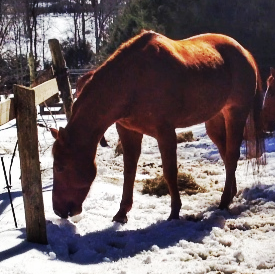North Carolina winters are consistently inconsistent. While we often have mild, sunny days that are perfect for a ride without the annoyance of summer bugs, the weather can change just as rapidly and turn cold and wet. Add in the near constant winter mud, and our equine companions can be faced with seasonal hoof challenges. Here are our some tips for keeping your horse’s feet in tip top shape this winter:
Mud tends to pile up around gates and walkways, and horses may be spending more time in the stall. All that standing around on wet ground can soften the hoof and provide the perfect breeding ground for thrush. Clean your horse’s feet often, and make sure he has dry ground to stand on at least part of the day.

While snowy days aren’t the norm for our part of the world, they can happen. Snow can pack and ball up in a horse’s feet, especially if they’re shod. Snowballs on the bottom of the feet can lead to slips, falls, and the potential for injury. If we do have a string of snowy days, it’s a good idea to check your pastured horse’s feet for snowballs, and check for snowy buildup throughout your ride.
Winter means a break from riding and showing for many horse owners. Often, it also means a break from shoeing for your horse. If you pull shoes during the winter months, it’s important to continue a regular trimming schedule, and inspect your horse’s feet for sole bruises. Bruises may present as areas of purple-red discoloration on the underside of the hoof. You may also see your horse walking more gingerly or even appearing lame.
If you have any questions about your horse’s feet, or if you suspect there may be an issue that needs to be addressed, please don’t hesitate to contact us for an appointment!



